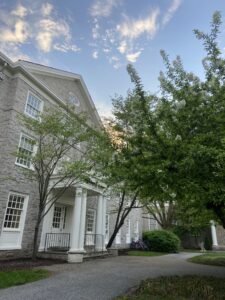
It is human nature to observe a culture or region and dismiss it as different from your own, to be studied from a distance or labeled as a force to be feared. In my opinion, many people find it easier to fear what is unknown rather than be curious to discover the world’s secrets. In other words, it is a common practice to assume that those who originate from cultures seemingly opposite to our own are more different to us than similar. I am here to challenge that attitude.

I strongly believe that we, as human beings, all have the same core needs: to be loved, to be accepted, to have freedom, and to learn. No matter how much one culture or way of life may vary from the other, it is my sentiment that we all operate in search of the aforementioned needs, and that we all have painfully similar lives even if the way in which we live them is different. Recently, I had the opportunity to test my theories because my collegiate International Relations class is participating in an exchange program with students studying at the American University of Sharjah (AUS) in the United Arab Emirates (UAE). This past week, students from my university, Dickinson College, and the AUS communicated over zoom where we discussed our definitions of ‘home’ and our daily routines and general interests.

I grew up in Kennett Square, Pennsylvania, a small town forty-five minutes outside of Philadelphia. In my childhood, life was not fast-paced but steady. In my hometown, I grew used to driving on windy backroads with friends, watching visions of rolling farmland flash past my windows; my extended family all lived within a ten mile radius of me, so I was used to being connected and supported through my early years. I attended public school, but I lived in a wealthy area that values education and white collar success, so very early on I was exposed to academic demand. One of my favorite things to do with friends and family is take day trips or travel for days at a time, but because of my dad’s crippling phobia of airplanes, I have never traveled outside of the country, so when faced with the opportunity to directly communicate with students across the globe, I was unsure of what to expect.
The AUS students that I spoke to were originally from Dubai, India and Sharjah, UAE, respectively. Both AUS students grew up in cities and lived in close proximities to their immediate and extended families, meaning that they actually lived in the same household as their extended families. The student originating from Sharjah recounted that there was often no room in her house to walk because the floor space was covered in beds to accomodate the population of the house. What I found to be interesting, however, was what this same student chose to share when AUS and Dickinson students were instructed to describe a place that feels like home; upon turning eighteen, this student moved into an apartment with her six siblings, living apart from her parents and extended family. Where I found commonality between my life experience and hers, however, was in the reason that her first apartment felt like home: she was finally able to feel independent from the sometimes stifling presence of her extended family while deepening her relationship with her siblings. Although I did not grow up in the city or face direct exposure to Emirati culture, I deeply relate to her want for independence and exploration, which I am searching for as I begin to live on my own at Dickinson. Similar to the Sharjah native, I shared with the group a place that I did not necessarily grow up in but that holds deep sentimental value to myself and my family: I pinned Lake Keowee, South Carolina on the shared padlet because it represents the nostalgia and relationship I share with my twin brother and cousins, whom I consider my closest friends. The fact that myself and someone across the world value family equally despite being raised in different cultural environments supports the notion that most human beings operate on similar psychological and spiritual needs.
When the conversation between myself and AUS students veered in a different direction from the proposed topic, “home,” we began to talk about Christmas. The AUS student originating from Dubai informed the group that she appreciated the nostalgic, magical mood surrounding the holidays in the U.S., and that she decorates her apartment with a Christmas tree, to which the Sharjah native voiced that she decorates her apartment with a Christmas tree, too. I found it curious that both AUS students chose to exercise their independence by assimilating to Western and Christian practices, especially one that challenges the religious majorities of each of their respective home countries. Although we exercise it in different ways, each one of us, regardless of cultural or ethnic background, holds our freedom to a high regard, feeling the need to be free from ideas pushed upon us and to learn how to navigate the wide world in front of us; in this way, we are all similar despite our differences.
As the conversation flowed to more general topics, my group compared the environmental factors of both campuses. The AUS students warned that their college is located in a hot and humid environment, where it is near impossible to walk across the large campus. Climate did not initially cross my mind as a factor expanding the difference in lifestyle between myself and AUS students, but it truly is an important factor to consider when attempting to paint a full picture of what someone’s life looks like. Where AUS students have to traverse a large campus in ovenlike weather, Dickinsonians enjoy life on a small campus where weather is seasonal, transitioning (sometimes unexpectedly) from hot, mild, and cold climates.
Before speaking with AUS students, I honestly did not know what to expect, or where we would find commonality. We, of course, are all different, with different personalities, experiences, cultural practices, livelihoods, interests, and customs, but, mostly, I found that I was surprised by the similarities we shared in value, in dream, and in need.
Leave a Reply